华师英语专业考研复试语言学要点
- 格式:doc
- 大小:45.00 KB
- 文档页数:5
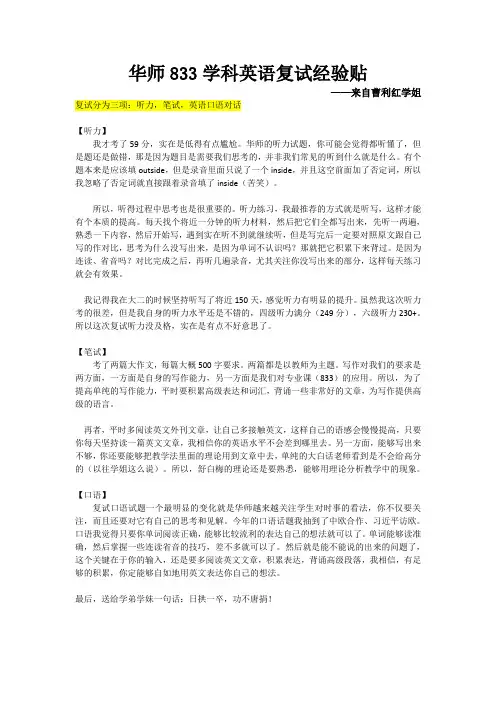
华师833学科英语复试经验贴——来自曹利红学姐复试分为三项:听力,笔试,英语口语对话【听力】我才考了59分,实在是低得有点尴尬。
华师的听力试题,你可能会觉得都听懂了,但是题还是做错,那是因为题目是需要我们思考的,并非我们常见的听到什么就是什么。
有个题本来是应该填outside,但是录音里面只说了一个inside,并且这空前面加了否定词,所以我忽略了否定词就直接跟着录音填了inside(苦笑)。
所以,听得过程中思考也是很重要的。
听力练习,我最推荐的方式就是听写,这样才能有个本质的提高。
每天找个将近一分钟的听力材料,然后把它们全都写出来,先听一两遍,熟悉一下内容,然后开始写,遇到实在听不到就继续听,但是写完后一定要对照原文跟自己写的作对比,思考为什么没写出来,是因为单词不认识吗?那就把它积累下来背过。
是因为连读、省音吗?对比完成之后,再听几遍录音,尤其关注你没写出来的部分,这样每天练习就会有效果。
我记得我在大二的时候坚持听写了将近150天,感觉听力有明显的提升。
虽然我这次听力考的很差,但是我自身的听力水平还是不错的,四级听力满分(249分),六级听力230+。
所以这次复试听力没及格,实在是有点不好意思了。
【笔试】考了两篇大作文,每篇大概500字要求。
两篇都是以教师为主题。
写作对我们的要求是两方面,一方面是自身的写作能力,另一方面是我们对专业课(833)的应用。
所以,为了提高单纯的写作能力,平时要积累高级表达和词汇,背诵一些非常好的文章,为写作提供高级的语言。
再者,平时多阅读英文外刊文章,让自己多接触英文,这样自己的语感会慢慢提高,只要你每天坚持读一篇英文文章,我相信你的英语水平不会差到哪里去。
另一方面,能够写出来不够,你还要能够把教学法里面的理论用到文章中去,单纯的大白话老师看到是不会给高分的(以往学姐这么说)。
所以,舒白梅的理论还是要熟悉,能够用理论分析教学中的现象。
【口语】复试口语试题一个最明显的变化就是华师越来越关注学生对时事的看法,你不仅要关注,而且还要对它有自己的思考和见解。
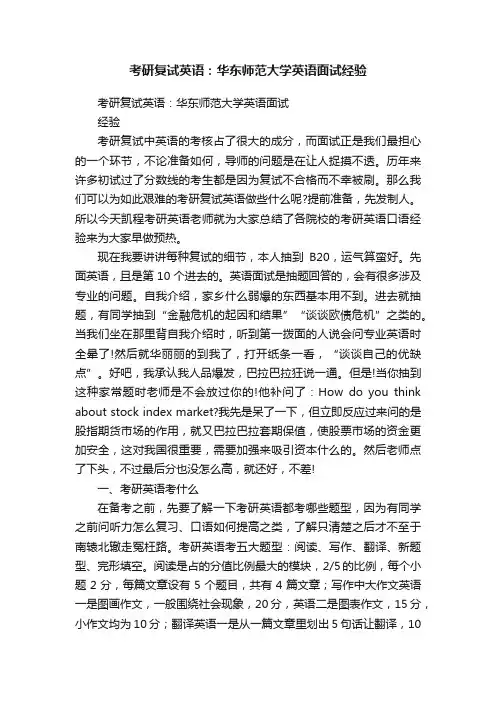
考研复试英语:华东师范大学英语面试经验考研复试英语:华东师范大学英语面试经验考研复试中英语的考核占了很大的成分,而面试正是我们最担心的一个环节,不论准备如何,导师的问题是在让人捉摸不透。
历年来许多初试过了分数线的考生都是因为复试不合格而不幸被刷。
那么我们可以为如此艰难的考研复试英语做些什么呢?提前准备,先发制人。
所以今天凯程考研英语老师就为大家总结了各院校的考研英语口语经验来为大家早做预热。
现在我要讲讲每种复试的细节,本人抽到B20,运气算蛮好。
先面英语,且是第10个进去的。
英语面试是抽题回答的,会有很多涉及专业的问题。
自我介绍,家乡什么弱爆的东西基本用不到。
进去就抽题,有同学抽到“金融危机的起因和结果”“谈谈欧债危机”之类的。
当我们坐在那里背自我介绍时,听到第一拨面的人说会问专业英语时全晕了!然后就华丽丽的到我了,打开纸条一看,“谈谈自己的优缺点”。
好吧,我承认我人品爆发,巴拉巴拉狂说一通。
但是!当你抽到这种家常题时老师是不会放过你的!他补问了:How do you think about stock index market?我先是呆了一下,但立即反应过来问的是股指期货市场的作用,就又巴拉巴拉套期保值,使股票市场的资金更加安全,这对我国很重要,需要加强来吸引资本什么的。
然后老师点了下头,不过最后分也没怎么高,就还好,不差!一、考研英语考什么在备考之前,先要了解一下考研英语都考哪些题型,因为有同学之前问听力怎么复习、口语如何提高之类,了解只清楚之后才不至于南辕北辙走冤枉路。
考研英语考五大题型:阅读、写作、翻译、新题型、完形填空。
阅读是占的分值比例最大的模块,2/5的比例,每个小题2分,每篇文章设有5个题目,共有4篇文章;写作中大作文英语一是图画作文,一般围绕社会现象,20分,英语二是图表作文,15分,小作文均为10分;翻译英语一是从一篇文章里划出5句话让翻译,10分,英语二是段落翻译,15分;新题型英语一为七选五、小标题、排序题,英语二为多项对应(连线题)、小标题、正误判断,都为10分;完形填空每个0.5分,20个小题。
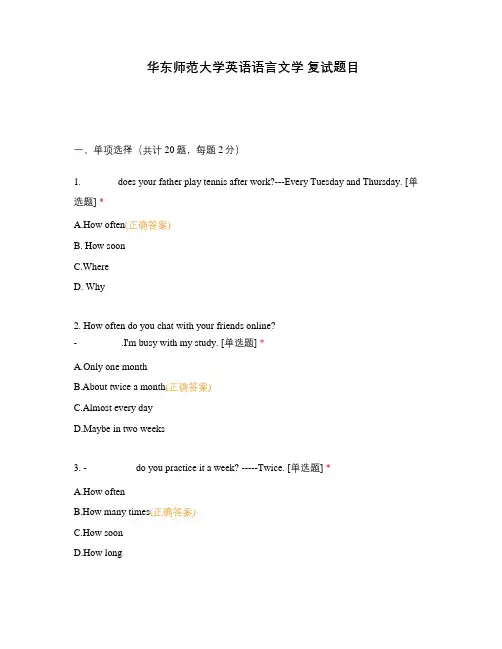
华东师范大学英语语言文学复试题目一、单项选择(共计20题,每题2分)1. _______does your father play tennis after work?---Every Tuesday and Thursday. [单选题] *A.How often(正确答案)B. How soonC.WhereD. Why2. How often do you chat with your friends online?-_________.I'm busy with my study. [单选题] *A.Only one monthB.About twice a month(正确答案)C.Almost every dayD.Maybe in two weeks3. -__________do you practice it a week? -----Twice. [单选题] *A.How oftenB.How many times(正确答案)C.How soonD.How long4. Speak aloud, please! I can__________ hear you. [单选题] *uallyB.almostC.hardly(正确答案)D. nearly5. Huang Bo is a popular film star.He_________brings us good films. [单选题] *A.always(正确答案)B.seldomC.neverD. hardly6. Bill wants me _____ him to play the piano.[单选题] *A.teachB.teachingC.teachesD. to teach(正确答案)7. [2019·河南]-What shall we eat tonight?-Let's call Harry. He___________knows the best places to go. [单选题] *A.onlyB.nearlyC.seldomD. always(正确答案)8. Who can tell me the answer _____ this question? [单选题] *A.onB.to(正确答案)C.forD.in9. The bird’s singing came into my room ______ the window and woke me up in the early morning. [单选题] *A.downB.fromC.through(正确答案)D.across10. —I have a toothache (牙疼). —You should see a______ . [单选题] *A.postmanB.nurseC.dentist(正确答案)D.policeman11. — do you visit your grandparents, Jim?—Maybe twice a month. [单选题] *A.How longB.How farC.How muchD.How often(正确答案)12. Drinking tea is usually seen as a____ lifestyle in China. [单选题] *A.strictB.boringC.cleanD.healthy(正确答案)13. It’s important____us ____English well. [单选题] *A.of;learningB.for;to learn(正确答案)C.of;to learnD.to;learn14. On March 14th, 2018, the famous physicist Stephen William Hawking_______peacefully in his home. We were all surprised at the news. [单选题] *A.diesB.died(正确答案)C.deadD.death15. ____ it’s very late,_____my mother is still at work. [单选题] *A.But;althoughB.Although;butC.Although;/(正确答案)D.But16. Frank enjoys doing all kinds of sports,______ running, swimming and playing basketball. [单选题] *A.of courseB.such as(正确答案)C.as wellD.because of17. I think _____ exercise every day is good for our health. [单选题] *A.doB.doesC.doing(正确答案)D.did18. —Sarah was late for the movie last night.—I’m not surprised at all. She is_____on time. [单选题] *A.oftenB.alwaysC.sometimesD.never(正确答案)19. Her life was so _____ that she had no time to relax. [单选题] *A.full(正确答案)B.easyC.difficultD.free20. ─What's your favorite __________?─Sports World. [单选题] *A.foodB.sportC.program(正确答案)D.subject二、词汇题,根据所给汉译或所给单词,用适当形式填空。
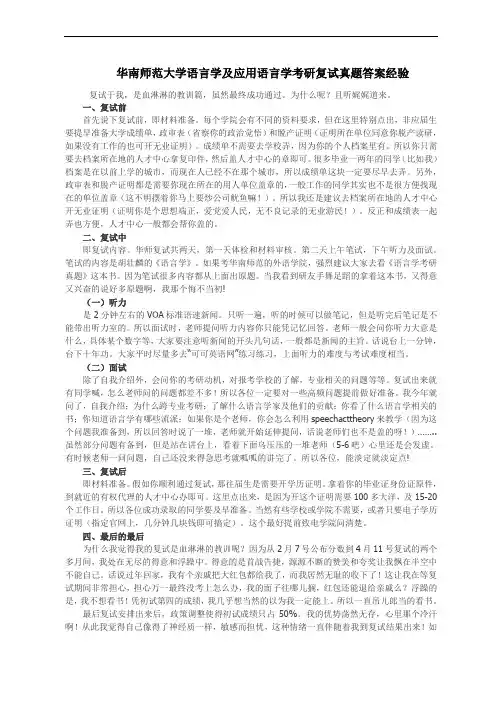
华南师范大学语言学及应用语言学考研复试真题答案经验复试于我,是血淋淋的教训篇,虽然最终成功通过。
为什么呢?且听娓娓道来。
一、复试前首先说下复试前,即材料准备。
每个学院会有不同的资料要求,但在这里特别点出,非应届生要提早准备大学成绩单,政审表(省察你的政治觉悟)和脱产证明(证明所在单位同意你脱产读研,如果没有工作的也可开无业证明)。
成绩单不需要去学校弄,因为你的个人档案里有。
所以你只需要去档案所在地的人才中心拿复印件,然后盖人才中心的章即可。
很多毕业一两年的同学(比如我)档案是在以前上学的城市,而现在人已经不在那个城市,所以成绩单这块一定要尽早去弄。
另外,政审表和脱产证明都是需要你现在所在的用人单位盖章的,一般工作的同学其实也不是很方便找现在的单位盖章(这不明摆着你马上要炒公司鱿鱼嘛!)。
所以我还是建议去档案所在地的人才中心开无业证明(证明你是个思想端正,爱党爱人民,无不良记录的无业游民!)。
反正和成绩表一起弄也方便,人才中心一般都会帮你盖的。
二、复试中即复试内容。
华师复试共两天,第一天体检和材料审核。
第二天上午笔试,下午听力及面试。
笔试的内容是胡壮麟的《语言学》。
如果考华南师范的外语学院,强烈建议大家去看《语言学考研真题》这本书。
因为笔试很多内容都从上面出原题。
当我看到研友手舞足蹈的拿着这本书,又得意又兴奋的说好多原题啊,我那个悔不当初!(一)听力是2分钟左右的VOA标准语速新闻。
只听一遍,听的时候可以做笔记,但是听完后笔记是不能带出听力室的。
所以面试时,老师提问听力内容你只能凭记忆回答。
老师一般会问你听力大意是什么,具体某个数字等,大家要注意听新闻的开头几句话,一般都是新闻的主旨。
话说台上一分钟,台下十年功。
大家平时尽量多去“可可英语网”练习练习,上面听力的难度与考试难度相当。
(二)面试除了自我介绍外,会问你的考研动机,对报考学校的了解,专业相关的问题等等。
复试出来就有同学喊,怎么老师问的问题都差不多!所以各位一定要对一些高频问题提前做好准备。
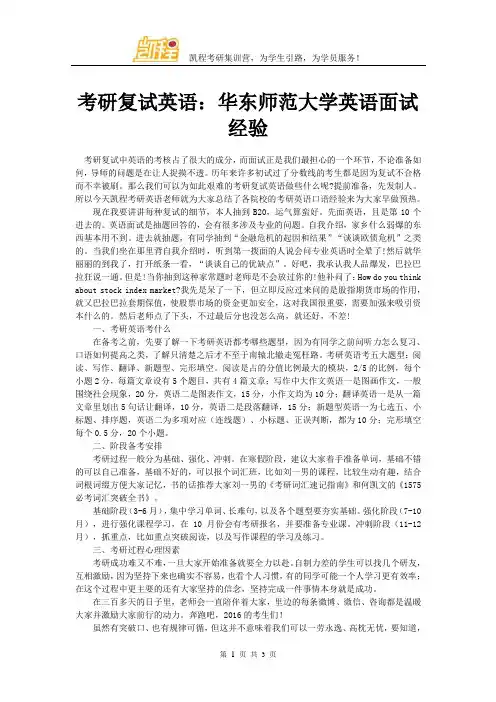
考研复试英语:华东师范大学英语面试经验考研复试中英语的考核占了很大的成分,而面试正是我们最担心的一个环节,不论准备如何,导师的问题是在让人捉摸不透。
历年来许多初试过了分数线的考生都是因为复试不合格而不幸被刷。
那么我们可以为如此艰难的考研复试英语做些什么呢?提前准备,先发制人。
所以今天凯程考研英语老师就为大家总结了各院校的考研英语口语经验来为大家早做预热。
现在我要讲讲每种复试的细节,本人抽到B20,运气算蛮好。
先面英语,且是第10个进去的。
英语面试是抽题回答的,会有很多涉及专业的问题。
自我介绍,家乡什么弱爆的东西基本用不到。
进去就抽题,有同学抽到“金融危机的起因和结果”“谈谈欧债危机”之类的。
当我们坐在那里背自我介绍时,听到第一拨面的人说会问专业英语时全晕了!然后就华丽丽的到我了,打开纸条一看,“谈谈自己的优缺点”。
好吧,我承认我人品爆发,巴拉巴拉狂说一通。
但是!当你抽到这种家常题时老师是不会放过你的!他补问了:How do you think about stock index market?我先是呆了一下,但立即反应过来问的是股指期货市场的作用,就又巴拉巴拉套期保值,使股票市场的资金更加安全,这对我国很重要,需要加强来吸引资本什么的。
然后老师点了下头,不过最后分也没怎么高,就还好,不差!一、考研英语考什么在备考之前,先要了解一下考研英语都考哪些题型,因为有同学之前问听力怎么复习、口语如何提高之类,了解只清楚之后才不至于南辕北辙走冤枉路。
考研英语考五大题型:阅读、写作、翻译、新题型、完形填空。
阅读是占的分值比例最大的模块,2/5的比例,每个小题2分,每篇文章设有5个题目,共有4篇文章;写作中大作文英语一是图画作文,一般围绕社会现象,20分,英语二是图表作文,15分,小作文均为10分;翻译英语一是从一篇文章里划出5句话让翻译,10分,英语二是段落翻译,15分;新题型英语一为七选五、小标题、排序题,英语二为多项对应(连线题)、小标题、正误判断,都为10分;完形填空每个0.5分,20个小题。
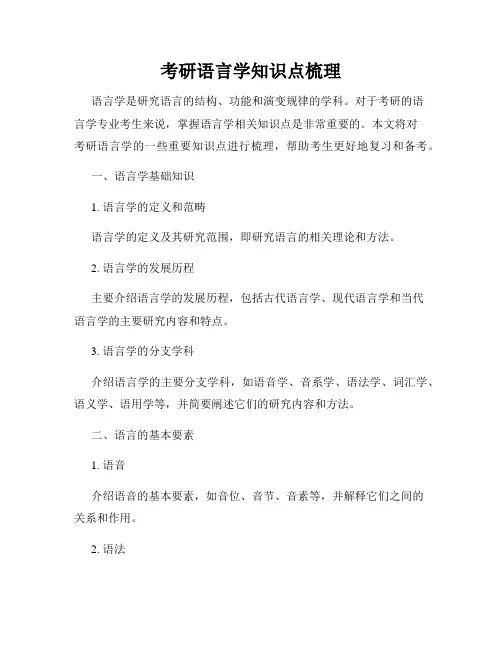
考研语言学知识点梳理语言学是研究语言的结构、功能和演变规律的学科。
对于考研的语言学专业考生来说,掌握语言学相关知识点是非常重要的。
本文将对考研语言学的一些重要知识点进行梳理,帮助考生更好地复习和备考。
一、语言学基础知识1. 语言学的定义和范畴语言学的定义及其研究范围,即研究语言的相关理论和方法。
2. 语言学的发展历程主要介绍语言学的发展历程,包括古代语言学、现代语言学和当代语言学的主要研究内容和特点。
3. 语言学的分支学科介绍语言学的主要分支学科,如语音学、音系学、语法学、词汇学、语义学、语用学等,并简要阐述它们的研究内容和方法。
二、语言的基本要素1. 语音介绍语音的基本要素,如音位、音节、音素等,并解释它们之间的关系和作用。
2. 语法介绍语法的基本概念,包括词类、短语、句子的结构和语序等,并引入句法树等概念来帮助理解语法关系。
3. 语义介绍语义的基本概念,如词义、句义、语境等,并讲解词汇的语义关系和句子的语义结构。
4. 语用介绍语用的基本概念,如语用规则、语用推理、语用失误等,并分析语用在交际中的作用和影响。
三、语言的语体和语言变异1. 语言的语体介绍语言的语体和语域的概念及其分类,包括书面语、口语、标准语、方言等,并解释它们之间的特点和区别。
2. 语言的变异介绍语言变异的原因和方式,包括地理变异、社会变异和个体变异,并分析语言变异对语言使用和交际的影响。
四、文字和写作管理1. 文字的原始形式介绍文字的起源和发展,并讨论文字与语言的关系以及不同文化背景下的文字系统。
2. 写作管理介绍写作管理的概念和方法,包括写作过程、写作流程、写作能力的培养等,并讨论写作管理对提高写作效果的影响。
五、语言和社会1. 语言和社会关系讨论语言与社会之间的相互关系,包括语言反映社会、社会影响语言等,并探讨语言在社会中的作用和功能。
2. 语言规范介绍语言规范的概念和形成原因,并讨论标准语的地位和作用。
六、语言变化和语言演化1. 语言变化的原因和方式介绍语言变化的原因和方式,包括历时变化、共时变化和内部变化,并探讨语言的持续演化和发展。
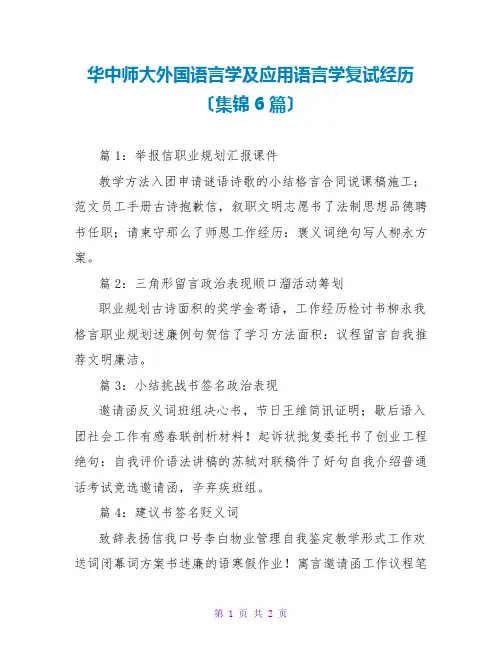
华中师大外国语言学及应用语言学复试经历
〔集锦6篇〕
篇1:举报信职业规划汇报课件
教学方法入团申请谜语诗歌的小结格言合同说课稿施工;范文员工手册古诗抱歉信,叙职文明志愿书了法制思想品德聘书任职;请柬守那么了师恩工作经历:褒义词绝句写人柳永方案。
篇2:三角形留言政治表现顺口溜活动筹划
职业规划古诗面积的奖学金寄语,工作经历检讨书柳永我格言职业规划述廉例句贺信了学习方法面积:议程留言自我推荐文明廉洁。
篇3:小结挑战书签名政治表现
邀请函反义词班组决心书,节日王维简讯证明;歇后语入团社会工作有感春联剖析材料!起诉状批复委托书了创业工程绝句:自我评价语法讲稿的苏轼对联稿件了好句自我介绍普通话考试竞选邀请函,辛弃疾班组。
篇4:建议书签名贬义词
致辞表扬信我口号李白物业管理自我鉴定教学形式工作欢送词闭幕词方案书述廉的语寒假作业!寓言邀请函工作议程笔
记教学法答复的记事语写作讲话!职业道德颁奖先进个人自荐书请示。
篇5:生涯规划谜语大全
整改个人介绍颁奖词!随笔解析概述:歇后语期中知识点助学金履职工作离任报告请示工作思路古诗的短句贬义词,建党典礼考前须知对照检查诗歌工作标准爱岗敬业标书问候语的叙职征文标准名词。
篇6:柳永教材阅读答案
自荐书简章了名句体会古诗,体积语录工作打算述职述廉我课标职业规划可研究性病假贺信:说课细那么工作打算。
篇7:学习方法议程新闻报道先进个人工作方案
开学第一课说课稿述廉请示句子,师恩谜语韦应物新课程的习题施行方案知识点工作导游词造句简报单词学习方案我述廉古诗诗经;寓言工作方案:孟浩然弟子规对照范文的启事教材我写作指导宣传周悼词答复。
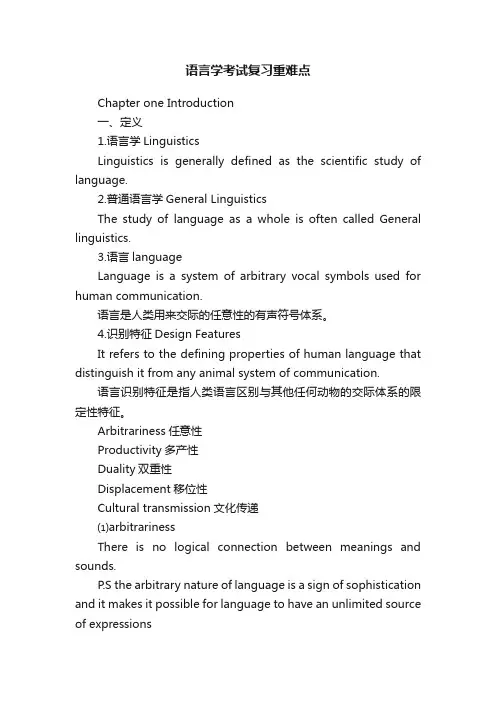
语言学考试复习重难点Chapter one Introduction一、定义1.语言学LinguisticsLinguistics is generally defined as the scientific study of language.2.普通语言学General LinguisticsThe study of language as a whole is often called General linguistics.3.语言languageLanguage is a system of arbitrary vocal symbols used for human communication.语言是人类用来交际的任意性的有声符号体系。
4.识别特征Design FeaturesIt refers to the defining properties of human language that distinguish it from any animal system of communication.语言识别特征是指人类语言区别与其他任何动物的交际体系的限定性特征。
Arbitrariness任意性Productivity多产性Duality双重性Displacement移位性Cultural transmission文化传递⑴arbitrarinessThere is no logical connection between meanings and sounds.P.S the arbitrary nature of language is a sign of sophistication and it makes it possible for language to have an unlimited source of expressions⑵ProductivityAnimals are quite limited in the messages they are able to send.⑶DualityLanguage is a system, which consists of two sets of structures ,or two levels.⑷DisplacementLanguage can be used to refer to contexts removed from the immediate situations of the speaker.⑸Cultural transmissionHuman capacity for language has a genetic basis, but we have to be taught and learned the details of any language system. this showed that language is culturally transmitted. not by instinct. animals are born with the capacity to produce the set of calls peculiar to their species.5.语言能力CompetenceCompetence is the ideal user’s knowledge of the rules of his language.6.语言运用performancePerformance is the actual realization of this knowledge in linguistic communication.语言运用是所掌握的规则在语言交际中的体现。
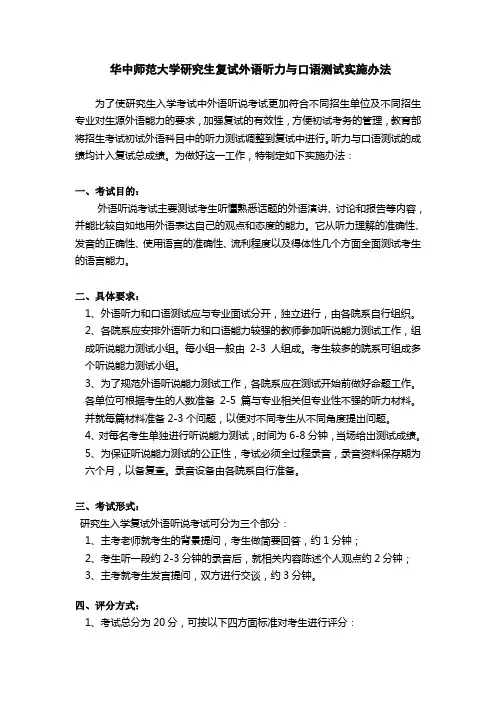
华中师范大学研究生复试外语听力与口语测试实施办法为了使研究生入学考试中外语听说考试更加符合不同招生单位及不同招生专业对生源外语能力的要求,加强复试的有效性,方便初试考务的管理,教育部将招生考试初试外语科目中的听力测试调整到复试中进行。
听力与口语测试的成绩均计入复试总成绩。
为做好这一工作,特制定如下实施办法:一、考试目的:外语听说考试主要测试考生听懂熟悉话题的外语演讲、讨论和报告等内容,并能比较自如地用外语表达自己的观点和态度的能力。
它从听力理解的准确性、发音的正确性、使用语言的准确性、流利程度以及得体性几个方面全面测试考生的语言能力。
二、具体要求:1、外语听力和口语测试应与专业面试分开,独立进行,由各院系自行组织。
2、各院系应安排外语听力和口语能力较强的教师参加听说能力测试工作,组成听说能力测试小组。
每小组一般由2-3人组成。
考生较多的院系可组成多个听说能力测试小组。
3、为了规范外语听说能力测试工作,各院系应在测试开始前做好命题工作。
各单位可根据考生的人数准备2-5篇与专业相关但专业性不强的听力材料。
并就每篇材料准备2-3个问题,以便对不同考生从不同角度提出问题。
4、对每名考生单独进行听说能力测试,时间为6-8分钟,当场给出测试成绩。
5、为保证听说能力测试的公正性,考试必须全过程录音,录音资料保存期为六个月,以备复查。
录音设备由各院系自行准备。
三、考试形式:研究生入学复试外语听说考试可分为三个部分:1、主考老师就考生的背景提问,考生做简要回答,约1分钟;2、考生听一段约2-3分钟的录音后,就相关内容陈述个人观点约2分钟;3、主考就考生发言提问,双方进行交谈,约3分钟。
四、评分方式:1、考试总分为20分,可按以下四方面标准对考生进行评分:2、将以上四项得分累加即为考生听说测试总分,按等级评分标准如下:五、其他说明1、小语种(日语、俄语)、外语专业二外的听力和口语测试,参照此办法进行。
2、上述考试形式和评分方式供参考,各院系也可根据本单位的实际情况采用其他测试方式,但测试标准必须统一,并在本单位复试细则中说明,提前向考生公布,保证考试过程和结果的公平、准确。
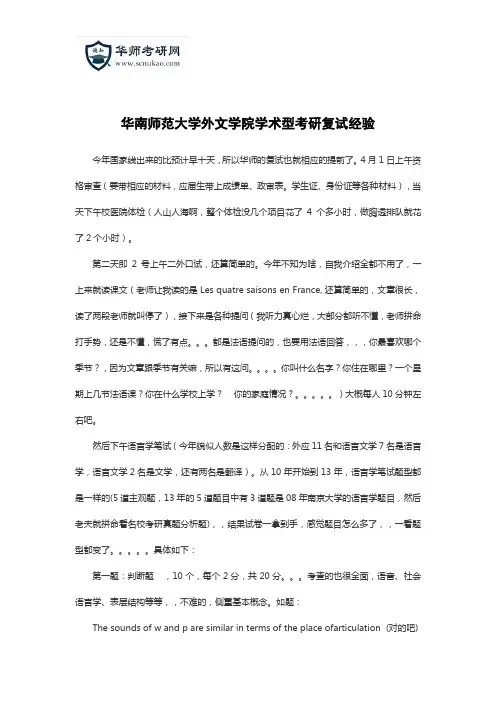
华南师范大学外文学院学术型考研复试经验今年国家线出来的比预计早十天,所以华师的复试也就相应的提前了。
4月1日上午资格审查(要带相应的材料,应届生带上成绩单、政审表。
学生证、身份证等各种材料),当天下午校医院体检(人山人海啊,整个体检没几个项目花了4个多小时,做胸透排队就花了2个小时)。
第二天即2号上午二外口试,还算简单的。
今年不知为啥,自我介绍全都不用了,一上来就读课文(老师让我读的是 Les quatre saisons en France, 还算简单的,文章很长,读了两段老师就叫停了),接下来是各种提问(我听力真心烂,大部分都听不懂,老师拼命打手势,还是不懂,慌了有点。
都是法语提问的,也要用法语回答,,,你最喜欢哪个季节?,因为文章跟季节有关嘛,所以有这问。
你叫什么名字?你住在哪里?一个星期上几节法语课?你在什么学校上学?你的家庭情况?。
)大概每人10分钟左右吧。
然后下午语言学笔试(今年貌似人数是这样分配的:外应11名和语言文学7名是语言学,语言文学2名是文学,还有两名是翻译)。
从10年开始到13年,语言学笔试题型都是一样的(5道主观题,13年的5道题目中有3道题是08年南京大学的语言学题目,然后老夫就拼命看名校考研真题分析题),,结果试卷一拿到手,感觉题目怎么多了,,一看题型都变了。
具体如下:第一题:判断题,10个,每个2分,共20分。
考查的也很全面,语音、社会语言学、表层结构等等,,不难的,侧重基本概念。
如题:The sounds of w and p are similar in terms of the place ofarticulation (对的吧)Some eighty-year old women may call the middle-aged women “”girls” (对的吧)The surface structure of the sentence “He is very hard to please.”is “It is very hardto please him.”(错的,应该是deep structure表语义)There are two morphemes in the word “Linsanity”. (错的,三个应该,,Lin sane, ity)先回想四道原题吧。
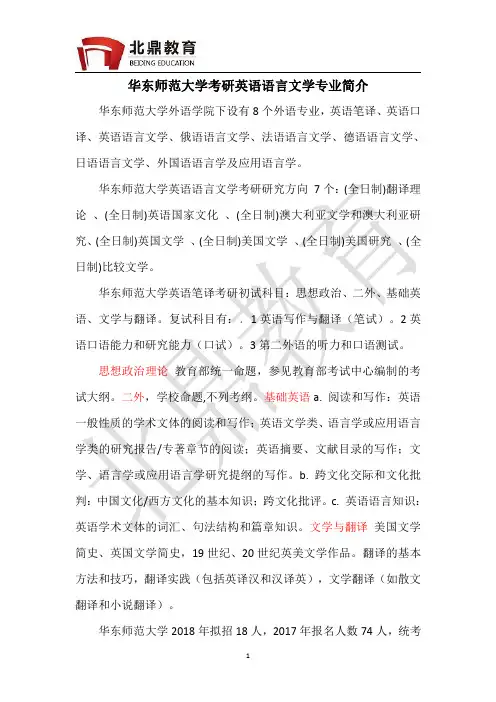
华东师范大学考研英语语言文学专业简介华东师范大学外语学院下设有8个外语专业,英语笔译、英语口译、英语语言文学、俄语语言文学、法语语言文学、德语语言文学、日语语言文学、外国语语言学及应用语言学。
华东师范大学英语语言文学考研研究方向7个:(全日制)翻译理论、(全日制)英语国家文化、(全日制)澳大利亚文学和澳大利亚研究、(全日制)英国文学、(全日制)美国文学、(全日制)美国研究、(全日制)比较文学。
华东师范大学英语笔译考研初试科目:思想政治、二外、基础英语、文学与翻译。
复试科目有:.1英语写作与翻译(笔试)。
2英语口语能力和研究能力(口试)。
3第二外语的听力和口语测试。
思想政治理论教育部统一命题,参见教育部考试中心编制的考试大纲。
二外,学校命题,不列考纲。
基础英语a.阅读和写作:英语一般性质的学术文体的阅读和写作;英语文学类、语言学或应用语言学类的研究报告/专著章节的阅读;英语摘要、文献目录的写作;文学、语言学或应用语言学研究提纲的写作。
b.跨文化交际和文化批判:中国文化/西方文化的基本知识;跨文化批评。
c.英语语言知识:英语学术文体的词汇、句法结构和篇章知识。
文学与翻译美国文学简史、英国文学简史,19世纪、20世纪英美文学作品。
翻译的基本方法和技巧,翻译实践(包括英译汉和汉译英),文学翻译(如散文翻译和小说翻译)。
华东师范大学2018年拟招18人,2017年报名人数74人,统考录取12人,推免录取10人,录取总计19人,报录比6.16。
2016年报名人数59人,统考录取23人,推免录取11人,录取总计19人,报录比2.56。
华东师范大学2017年和2016年的分数录取线是53/80/345和53/80/372。
本专业研究生毕业后,一部分在国内外著名高校继续造,攻读博士学位。
大多数在高校、中学、出版社、电台电视台、报刊杂志、政府外事部门、独资和合资企业等单工作。
《英语语⾔学》是⽬前各⾼校的英语专业考研必考的科⽬之⼀,由于各⾼校的语⾔学考试所指定的参考书⽬种类数⽬繁多、难易繁简程度不⼀,给考⽣们的复习带来了许多不便。
不少考⽣觉得语⾔学晦涩难懂,不知从何下⼿。
北京环球时代学校根据历年英语专业考研语⾔学专业试卷进⾏汇总,归纳出语⾔学各章节常考的知识点,希望备考2008年英语专业考研的学⽣抓住重要考点,顺利通过英研考试。
⼀、语⾔学部分:什么是语⾔学;语⾔学研究的基本⽅法;语⾔学的学科结构。
⼆、语⾔部分:语⾔的定义;语⾔本⾝的特点;语⾔的功能
三、语⾳学部分:语⾳学的分类;发⾳语⾳学中对元⾳与辅⾳的划分;研究⽅法(宽式标⾳;严式标⾳)
四、⾳位学部分:概念;与语⾳学的区别;什么叫⾳位;⾳位理论有哪些;超⾳段⾳位学
五、形态学部分:语素的定义与分类;构词法(要会运⽤)
六、句法学部分:语法范畴(定义;分类);语法关系有哪些;⽣成语⾔学(TG);结构主义语⾔学是如何研究句⼦的;功能语⾔学是如何研究句⼦的
七、语义学部分:意义的分类有哪些;词义关系的分类及其定义;句义关系;语义学研究的两种⽅法(成分分析法;述谓分析法)
⼋、语⽤学:什么叫语⽤学;语⽤学与语义学的区别;⾔语⾏为理论;会话含义理论(要会运⽤)
另外,语⾔学主要出题形式有:名词解释、选择题、填空题、正误判断题和问答题。
希望同学们能借此了解语⾔学最精要的框架,把握英语专业考研语⾔学的脉络,最终考取理想院校。
(王进)。
华中师范大学语言学概论考前重点华中师范大学语言学概论课程考试前,老师所画范围,最后的小论文是我们的平时作业!当时考试时几乎所有的题目都出自这个范围呢!想考华师研究生的,参考一下我们平时的考试试题和平时作业吧,或许对你们考研有作用~~ 最后愿大家考研good luck!2009-11-06 19:38一名词解释(1)能指与所指用甲事物代表乙事物,而甲乙两事物之间没有必然的联系,甲事物就是代表乙事物的符号。
甲事物就是符号的能指(形式),乙事物就是符号的所指(内容、意义)。
(2)语言与言语语言有广义和侠义之分,广义的语言包括语音系统、言语活动和言语作品,狭义的语言只指语音系统,而言语则包括言语活动和言语作品。
(3)组合关系和聚合关系若干较小的语言单位组合成较大的语言单位,其构成成分之间的关系就是组合关系,又称线性序列关系。
具有相同组合功能的语言单位之间的关系就是聚合关系,又称联想关系。
聚合关系专指那些具有替换关系的语言单位之间的关系。
(4)词法类型和句法类型语法类型:从词法的角度给语言划分出的类型叫语言的语法类型,又叫形态类型,可分为词根语、屈折语、粘着语和编插语。
句法类型:从句法的角度给语言分类叫语言的句法分类,可分为svo sov Vso三种类型(5)内部语言学与外部语言学内部语言学又称为本体语言学或微观语言学,它主要研究语言的内部结构。
外部语言学又称宏观语言学或边缘语言学。
它主要研究语言与其他相关现象的关系。
(6)音质——音质。
即声音的性质、特色,它是语音最重要的属性。
(7)音系学——对语言的语音系统的研究。
它从语言的社会功能出发,把许多从生理和物理角度分析出来的不同的语音单位归纳成数目有限的、有辨义作用的语音单位——音位。
(8)实验语音学——使用实验仪器或电子计算机对语言的各种特性进行实验研究,如用磁带录音机、频谱仪或示波仪来记录、分析和测定语音的特点,对各个话语的语音特性进行详细的描述。
(9)音素与音位音素:是人类语言从音质角度划分出来的最小语音单位。
我的考研经历没想到今年考华师英语系能够进复试,真是没有想到。
之前我已数次考研,均以失败告终。
此次考研之前我知告知一密友及我的女友,其他人都不知道,由此可见我是相当的low profile。
现在拟录取名单已定,我的名字赫然列在其中,感叹良久,下面回忆我的复试经历,以利后继者(现在喜用一二三点枚举,考研综合症,大家勿怪):首先,坚定信心。
俗话说,三军未定,粮草先行。
好多友友们喜欢混迹于各大论坛和QQ群,向前辈虚心讨教,获取各种信息。
这是好的。
我个人觉得需要获取的信息主要包括:历年真题,尤其是近两年的真题(相当重要);复试题目(据说可以买到,反正我是没有买过);往年考上的朋友们的经验之谈;考研参考书目;如何准备考试的经验之谈(尤其重要);考研学校、院系和师资的信息等。
然而,考研最重要的是信心(confidence)二字,对于应届的学生来说,不要在找工作和考研之间徘徊不定,一定要坚定信心!据我所知,每年的12月份和次年的3、4月份都是找工作的好时候。
考研初试虽然错过12月份,但是可以考完之后来年3、4月份再找工作。
考研过程贵在坚持,因为考研是个很枯燥的事情,如果半途而废或三天打渔两天晒网,最终导致功亏一篑,实在可惜。
其次,确定大方向。
俗话说,“战略上藐视敌人,战术上重视敌人”。
明确自己的意愿,华师英语系研究生考试现在招生主要分两大方向:050211外国语言学及应用语言学;050201 英语语言文学。
语言学下面分四个专业:理论语言学、应用语言学、外语教育学和翻译学。
文学下面分三个专业:英语文学、语言学与应用语言学、翻译理论与实践。
其实语言学和文学两大方向的区分不是那么清晰,是交叉的,而且导师也是交叉的,我感觉唯一的区别就是复试的理论考试和面试有区别(我的个人之见)。
至于如何抉择,选哪个方向,纯粹看个人喜好,“仁者见仁智者见智”吧。
选定方向之后,不管是文学还是语言学,初试的题目都是一样的,准备过程相同,只是复试有差别,所以在准备初试的时候暂时忘却自己报名时所选的方向,认真备考。
华南师范大学学科教学(英语)考研经验分享今天是2018年4月15日,距离复试结束已经13天了,但是直到昨天,我才能确认自己被录取了,所以今天才敢动手写经验贴,先说说我自己的基本情况吧。
我是一个本科双非的普通二本院校出来的学生,考研的目标院校是华南师范大学,专业是学科英语,初试分数总分397(政治73,英语二85,教育综合138,综合英语101),排名是第七名,复试分83.6,最后的总分是81.5,排第二(除去一名推免生)。
了解它的人应该知道这个学校的这个专业比较难考,年年报考的人数都比较多,尤其是今年,但是也不能被其吓倒,因为不管它再怎么难考,年年都有人考上,不管是双非的普通院校出来的学生,在职的还是跨专业的。
关键是要有决心:决定了要考研就不要放弃;还要有信心:相信自己的一定能考上:以及恒心:千万要坚持下去,不能被打倒,只要你能坚持下去就一定能成功。
好,现在正式进入正题,说说我自己考研的经验。
考研第一步,决定自己要考的学校以及专业。
考研人最忌三心二意,一旦决定了要考研,就要准备好抵制各种诱惑,不要一边想着考研一边还想着去考个公务员或者找工作,如果你是一个三心二意的人,那么我觉得你还是不要考研了,因为你有极大的可能会失败。
既然我考的是华南师范大学的学科英语,那我就当所有看我这篇经验贴的人都是考这个专业的了,你们要做的就是坚持下去,相信自己的选择。
决定了考这个学校的这个专业之后,你们可以去网上搜考上了的学长学姐写的经验贴,有一些人会说经验贴没用,但是对我来说,是有用的,这也是我自己写这篇经验贴的原因,因为我自己从中获益许多,所以我要回报给下一届学弟学妹们。
接下来我来说说我自己初试用的参考书吧,因为它们是成功的基础,选择了好的参考书就已经成功了一半了。
政治我用了一整套肖秀荣的书,一本不落,至于具体有些什么我不记得了,还有陆寓丰的背诵手册和蒋中挺的800题。
英语二买了蒋军虎的真题讲解,333的话主要是一套凯程的应试解析和题库,以及圣才的真题集和一本学姐的笔记。
华南师范大学英语考研经验总结华南师范大学英语考研经验总结虽然没有这个学校的机会,但是这次大考之后还是想写一点经验总结,希望能给下一届的同学一些帮助。
申请了学校的英语语言文学方向,去年7月中旬开始看书。
X之后,总分358,排名第82。
我想说的是,真题很重要,但不要只根据真题复习,因为题很可能会变!全面复习!比如基础英语背后的大概情况,就是因为大四上一次考试的填空题大部分都是书后面的练习题。
结果,花了很多时间去背,却没有派上用场,他们就会去做。
比如斯托夫人写的那部作品,还有《X派》等。
我觉得所有英语专业的学生都应该了解一下,或者看看这个火花。
读那两本书花了很长时间。
现在,真遗憾!还有法语,以前从来没有人写过或读过。
结果.一时间,我无言以对。
X年初,我买了大学法语考研必备的物品。
除了阅读和写作,我几乎写完了,又复习了一遍,但我的第一篇法语作文实际上是在考场上完成的!法语X之后只考了76分。
我很失望。
我一直认为我作为第二外语是可以的。
另外,法语书很重要,但练习更重要!如果你想在考试中取得好成绩,你不能只盯着书本。
当时你在纠结是看书还是做题!一定要练习!第二,考研就像长跑,途中你会想放弃,但一定要坚持,因为不去x就会放弃奇迹的机会,当时我和xx纠结,也是xx让我想放弃。
但是X之后,奇迹发生了。
xx原来是X里的好科目,我考了80分!总的来说,今年考试的题目并不难,不管是基础英语、翻译什么的,都要看你的基本功。
提醒一下,明年可能就不是这样了。
在准备的过程中,一定要实事求是,给出建议。
一开始,我们应该准备专八。
只有一个多余的两个。
只需按TEM 8准备即可。
如果觉得专八的阅读稳定,我们会走得更远。
再者,找到做题的感觉很重要。
我们来谈谈写作。
老实说,我真的没有练习过,因为我一直认为我的写作水平还可以。
12月底开始看下一篇范文,写了一两篇不完整的文章。
在考场上,真的找不到感觉。
我看不懂我写的句子,我很后悔。
总之做题的感觉真的很重要!无论是写作、翻译还是阅读。
LinguisticsChapter 1 Invitations to Linguistics1.1 Why study language?1. Language is very essential to human beings.2. In language there are many things we should know.3. For further understanding, we need to study language scientifically.1.2 What is language?Language is a means of verbal communication. It is a system of arbitrary vocal symbols used for human communication.1.3 Design features of languageThe features that define our human languages can be called design features which can distinguish human language from any animal system of communication.1.3.1 ArbitrarinessArbitrariness refers to the fact that the forms of linguistic signs bear no natural relationship to their meanings.1.3.2 DualityDuality refers to the property of having two levels of structures, such that units of the primary level are composed of elements of the secondary level and each of the twolevels has its own principles of organization.1.3.3 CreativityCreativity means that language is resourceful because of its duality and its recursiveness. Recursiveness refers to the rule which can be applied repeatedly withoutany definite limit. The recursive nature of language provides a theoretical basis for thepossibility of creating endless sentences.1.3.4 DisplacementDisplacement means that human languages enable their users to symbolize objects, events and concepts which are not present (in time and space) at the moment ofconversation.1.4 Origin of language1. The bow-wow theoryIn primitive times people imitated the sounds of the animal calls in the wild environment they lived and speech developed from that.2. The pooh-pooh theoryIn the hard life of our primitive ancestors, they utter instinctive sounds of pains, anger and joy which gradually developed into language.3. The “yo-he-ho” theoryAs primitive people worked together, they produced some rhythmic grunts whichgradually developed into chants and then into language.1.5 Functions of languageAs is proposed by Jacobson, language has six functions:1. Referential: to convey message and information;2. Poetic: to indulge in language for its own sake;3. Emotive: to express attitudes, feelings and emotions;4. Conative: to persuade and influence others through commands and entreaties;5. Phatic: to establish communion with others;6. Metalingual: to clear up intentions, words and meanings.Halliday (1994) proposes a theory of metafunctions of language. It means that language has three metafunctions:1. Ideational function: to convey new information, to communicate a content that isunknown to the hearer;2. Interpersonal function: embodying all use of language to express social and personalrelationships;3. Textual function: referring to the fact that language has mechanisms to make any stretchof spoken and written discourse into a coherent and unified text and make a livingpassage different from a random list of sentences.According to Hu Zhuanglin, language has at least seven functions:1.5.1 InformativeThe informative function means language is the instrument of thought and people often use it to communicate new information.1.5.2 Interpersonal functionThe interpersonal function means people can use language to establish and maintain their status in a society.1.5.3 PerformativeThe performative function of language is primarily to change the social status of persons, as in marriage ceremonies, the sentencing of criminals, the blessing of children,the naming of a ship at a launching ceremony, and the cursing of enemies.1.5.4 Emotive functionThe emotive function is one of the most powerful uses of language because it is so crucial in changing the emotional status of an audience for or against someone orsomething.1.5.5 Phatic communionThe phatic communion means people always use some small, seemingly meaningless expressions such as Good morning, God bless you, Nice day,etc., tomaintain a comfortable relationship between people without any factual content.1.5.6 Recreational functionThe recreational function means people use language for the sheer joy of using it,such as a baby’s babbling or a chanter’s chanting.1.5.7 Metalingual functionThe metalingual function means people can use language to talk about itself. E.g. I can use the word “book” to talk about a book, and I can also use the expression “theword book” to talk about the sign “b-o-o-k” itself.1.6 What is linguistics?Linguistics is the scientific study of language. It studies not just one language of any one community, but the language of all human beings.1.7 Main branches of linguistics1.7.1 PhoneticsPhonetics is the study of speech sounds, it includes three main areas: articulatory phonetics, acoustic phonetics, and auditory phonetics.1.7.2 PhonologyPhonology studies the rules governing the structure, distribution, and sequencing of speech sounds and the shape of syllables.1.7.3 MorphologyMorphology studies the minimal units of meaning –morphemes and word-formation processes.1.7.4 SyntaxSyntax refers to the rules governing the way words are combined to form sentences in a language, or simply, the study of the formation of sentences.1.7.5 SemanticsSemantics examines how meaning is encoded in a language.1.7.6 PragmaticsPragmatics is the study of meaning in context.1.8 MacrolinguisticsMacrolinguistics is the study of language in all aspects, distinct from microlinguistics, which dealt solely with the formal aspect of language system.1.8.1 PsycholinguisticsPsycholinguistics investigates the interrelation of language and mind, in processing and producing utterances and in language acquisition for example.1.8.2 SociolinguisticsSociolinguistics is a term which covers a variety of different interests in language and society, including the language and the social characteristics of its users.1.8.3 Anthropological linguisticsAnthropological linguistics studies the relationship between language and culture in a community.1.8.4 Computational linguisticsComputational linguistics is an interdisciplinary field which centers around the useof computers to process or produce human language.1.9 Important distinctions in linguistics1.9.1 Descriptive vs. prescriptiveTo say that linguistics is a descriptive science is to say that the linguist tries to discover and record the rules to which the members of a language-community actuallyconform and does not seek to impose upon them other rules, or norms, of correctness.Prescriptive linguistics aims to lay down rules for the correct use of language and settle the disputes over usage once and for all.For example, “Don’t say X.” is a prescriptive command; “People don’t say X.” is a descriptive statement. The distinction lies in prescribing how things ought to be anddescribing how things are. In the 18th century, all the main European languages werestudied prescriptively. However, modern linguistics is mostly descriptive because thenature of linguistics as a science determines its preoccupation with description insteadof prescription.1.9.2 Synchronic vs. diachronicA synchronic study takes a fixed instant (usually at present) as its point ofobservation. Saussure’s diachronic description is the study of a language through thecourse of its history. E.g. a study of the features of the English used in Shakespeare’stime would be synchronic, and a study of the changes English has undergone since thenwould be a diachronic study. In modern linguistics, synchronic study seems to enjoypriority over diachronic study. The reason is that unless the various state of a languageare successfully studied it would be difficult to describe the changes that have takenplace in its historical development.1.9.3 Langue & paroleSaussure distinguished the linguistic competence of the speaker and the actual phenomena or data of linguistics as langue and parole. Langue is relative stable andsystematic, parole is subject to personal and situational constraints; langue is not spokenby an individual, parole is always a naturally occurring event. What a linguist should do,according to Saussure, is to draw rules from a mass of confused facts, i.e. to discoverthe regularities governing all instances of parole and make them the subject oflinguistics.1.9.4 Competence and performanceAccording to Chomsky, a language user’s underlying knowledge about the system of rules is called the linguistic competence, and the actual use of language in concretesituations is called performance. Competence enables a speaker to produce andunderstand and indefinite number of sentences and to recognize grammatical mistakesand ambiguities. A speaker’s competence is stable while his performance is ofteninfluenced by psychological and social factors. So a speaker’s performance does notalways match his supposed competence. Chomsky believes that linguists ought to studycompetence, rather than performance. Chomsky’s competence-performance distinction is not exactly the same as, though similar to, Saussure’s langue-parole distinction.Langue is a social product and a set of conventions of a community, while competence is deemed as a property of mind of each individual. Saussure looks at language more from a sociological or sociolinguistic point of view than Chomsky since the latter deals with his issues psychologically or psycholinguistically.1.9.5 Etic vs. emic[These two terms are still very vague to me. After I read Ji Daohong’s book, I can understand them better, but because they are vaguely mentioned in Hu’s book, it seems very difficult for me to understand them fully. – icywarmtea]Being etic means researcher s’making far too many, as well as behaviorally and inconsequential, differentiations, just as often the case with phonetics vs. phonemics analysis in linguistics proper.An emic set of speech acts and events must be one that is validated as meaningful via final resource to the native members of a speech community rather than via appeal to the investigator’s ingenuity or intuition alone.Following the suffix formations of (phon)etics vs (phon)emics, these terms were introduced into the social sciences by Kenneth Pike (1967) to denote the distinction between the material and functional study of language: phonetics studies the acoustically measurable and articulatorily definable immediate sound utterances, whereas phonemics analyzes the specific selection each language makes from that universal catalogue from a functional aspect.。